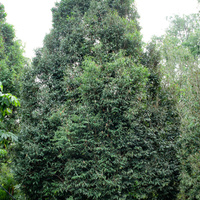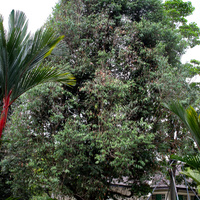Common name: Ceylon ironwood
Other common names: Indian rose chestnut, Ironwood tree, Poached egg tree
Description
Mesua or Ceylon ironwood is an ornamental and timber tree originating in the south-west and north-east of India, extending into Myanmar (Burma), Thailand, Malaysia, Vietnam and Indonesia.
It is a slow-growing tree, to heights of up 30 m (98 ft) under favourable conditions with a straight trunk and buttresses at the base of large trees, though is more typically 10 to 20 m (30 to 60 ft) tall. In young trees, the crown is pyramidal-shaped, neat and low-branching. As the tree ages, the lower branches shed and the crown becomes more rounded. The bark grey, on young trees smooth, giving way to peeling bark as the tree ages.
Leaves lance-shaped, 7 to 12 cm (3 to 5 in) long and remain on the tree throughout the year. When the new leaves emerge they are a brilliant red, in spectacular flushes triggered by rising humidity. They give the appearance from a distance of a tree in full bloom. As they age their bright red colour fades to pink, then they become dark glossy green.
The flowers are four-petaled, 3 to 10 cm (1.2 to 4 in) wide, white with yellow centres and sweetly fragrant. They bloom from winter to spring, coinciding with the dry season in its native range, and are followed by small egg-shaped, woody seed capsules with a pointed tip and one to four oily seed inside.
Use
It is an outstanding ornamental with its neat, shapely form, brilliant red foliage and large fragrant flowers. It is often planted as a street or avenue tree in its native range.
Mesua produces a heavy reddish-brown wood, in the 800 to 900 kgs per cubic meter (50 to 56 lbs per cubic ft) range with high natural resistance to rot and decay, making it fit for indoor and outdoor construction. The sawn timber is used in heavy construction, including boat and bridge building and for making crossties or sleepers for railway tracks. The roundwood is shaped into tool handles.
On cold mechanical pressing, the seed yields up to 70% of a dark brown, viscid oil. It has an unpleasant aroma that is removed by refining and is used in making soap and lubricants, and long ago as an illuminant for lamps and lanterns.
Climate
Grows naturally in humid tropical lowland to mid-elevation climates, generally areas with annual lows of 18 to 24°C, annual highs of 27 to 33°C, annual rainfall of 1500 to 5500 mm and a dry season of 6 months or less. It reaches its best development in areas with annual rainfall of 2000 mm or more.
Growing
New plants are started from seed or cuttings grown in a humid, misted environment. The seed are extracted from fruit that have been left out in the sun to split then shade-dried. The only remain viable for a short time, needing to be sown soon after extraction from the fruit.
It performs best on free-draining clay and loam soils of a moderately acid to neutral nature, generally with a pH of 5.0 to 7.0, and on sites with full to partial sun exposure.
Problem features
There does not appear to be any records of it escaping cultivation and naturalising anywhere. It is assessed as a low weed risk species for Hawaii by the Hawaii Pacific Weed Risk Assessment (HPWRA) project.
The resin exude is reported to be toxic to humans if ingested.
Where it grows
References
Books
-
Barwick, M., et al. 2004, Tropical & subtropical trees : a worldwide encyclopaedic guide, Thames and Hudson, London
-
C.A.B. International 2013, The CABI encyclopedia of forest trees, CABI Publishing, Wallingford, Oxfordshire
-
Champion, H. G. & Seth, S. K. 1968, A revised survey of the forest types of India, Natraj Publishers, Dehradun, India
-
Chudnoff, M. 1984, Tropical timbers of the world, Forest Service, U.S. Department of Agriculture (USDA), Washington, D.C.
-
Dey, S.C. 1996, Fragrant flowers for homes and gardens, trade and industry, Abhinav Publications, New Delhi, India
-
Holttum, R. E. & Enoch, I. C. 2010, Gardening in the tropics : the definitive guide for gardeners, Marshall Cavendish Editions, Singapore
-
Krishen, P. 2006, Trees of Delhi : a field guide, Dorling Kindersley Publishers, Delhi
-
Letourneux, C. 1957, Tree planting practices in tropical Asia, Food and Agriculture Organization of the United Nations (FAO), Rome
-
Luna, R. K 1996, Plantation trees, International Book Distributors, Dehradun, Uttarakhand
-
Macmillan, H. F. 1943, Tropical planting and gardening : with special reference to Ceylon, 5th ed, Macmillan Publishing, London
-
Menninger, E. A. 1962, Flowering trees of the world for tropics and warm climates, 1st ed., Heathside Press, New York
-
Randall, R. P. 2007, The introduced flora of Australia and its weed status, Cooperative Research Centre for Australian Weed Management, Glen Osmond, South Australia
-
Scheffer, T. C & Morrell, J. J. 1998, Natural durability of wood : a worldwide checklist of species, Forest Research Laboratory, Oregon State University, Corvallis, Oregon
Articles, Journals, Reports and Working Papers
-
Singh, K. P. & Kushwaha, C. P. 2006, Diversity of flowering and fruiting phenology of trees in a tropical deciduous forest in India, Oxford University Press
-
Somashekhar, B. S. and M. Sharma. 2002. Training manual on propagation techniques of commercially important medicinal plants. Foundation for Revitalisation of Local Health Traditions, Bangalore, India.



